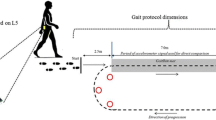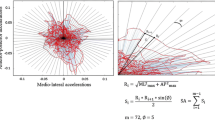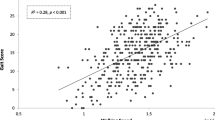Abstract
Background
The RehaWatch® system is a portable accelerometer for measurement of gait parameters that shows good validity in young adults; however, validity data are missing for elderly persons in long-term care (LTC).
Aim
The aim was to evaluate the concurrent validity of the RehaWatch® system using the GAITRite® system as a criterion reference for gait assessment in the LTC elderly.
Material and methods
In this study 23 elderly participants (mean age 90.9 ± 8.4 years) performed 4 walking trials at normal and fast walking speed during single task and dual task walking. Data for both systems were collected simultaneously for each trial. Concurrent validity was assessed through limits of agreement (LoA) methodology using Bland-Altman plots.
Results
No systematic bias could be determined. Mean biases for step duration, velocity and cadence were above the prespecified ±7 % value from zero lines for normal walking during single task and dual task walking. The LoA had a wide range between −21 % and 25 %. Only cadence showed small LoA for normal walking speed during single (−8.4 % to 7.7 %) and dual tasking (−4.1 % to 3 %). Heterogeneous bias was determined for step duration during fast walking during dual task and for velocity during fast walking during single task and dual task. Heteroscedasticity was shown for step length during normal walking under the dual task condition and fast walking during single task and dual task activities.
Conclusion
No gait parameters are interchangeably usable between the two systems for normal walking during single task and dual task activities.
Zusammenfassung
Hintergrund
Das RehaWatch® System ist ein tragbares Beschleunigungsmessgerät zur Messung von Gangparametern, das eine gute Validität bei jungen Erwachsenen zeigt. Allerdings fehlen Daten zur Validität bei älteren Menschen in Langzeitpflege.
Ziel
Das Ziel dieser Studie war es, die Validität des RehaWatch®-Systems mit dem GAITRite®-System bei älteren Menschen in Langzeitpflege zu vergleichen.
Material und Methoden
In dieser Studie führten 23 ältere Probanden (Durchschnittsalter: 90,9 ± 8,4 Jahre) bei normaler und hoher Laufgeschwindigkeit Einfach- und Doppelaufgaben aus. Dabei wurden gleichzeitig Daten vom RehaWatch®-System und dem GAITRite®-System gesammelt, um mittels Bland-Altman-Plots die Übereinstimmungsgrenzen festzustellen.
Ergebnisse
Es konnte kein systematischer bestimmt werden. Der mittlere Bias für Schrittdauer, Laufgeschwindigkeit und Trittfrequenz lag über die zuvor festgelegten Grenze von ±7 % für normales Gehen mit Einfach- und Doppelaufgaben. Die Übereinstimmungsgrenzen lagen zwischen −21 und 15 %. Nur die Kadenz zeigte eine schmale Übereinstimmungsgrenze für Einfachaufgaben (−4,1 bis 3 %) und Doppelaufgaben (−8,4 bis 7,7 %). Heterogene Bias wurden für die Schrittdauer beim schnellen Gehen für Doppelaufgaben und für die Geschwindigkeit beim schnellen Gehen für Einfach- und Doppelaufgaben bestimmt. Die Heteroskedastizität wurde für die Schrittlänge während des normalen Gehens mit Doppelaufgaben und des schnellen Gehens mit Einfachaufgaben ermittelt.
Schlussfolgerung
Für normales Gehen mit Einfach- und Doppelaufgaben kann zwischen den beiden Systemen kein Gangparameter genutzt werden.




Similar content being viewed by others
References
Altman DG, Bland JM (1999) How to randomise. BMJ 319:703–704
Altman DG, Bland JM (1983) Measurement in medicine: the analysis of method comparison studies. Statistician 32:307–317
Anstey KJ, Von Sanden C, Luszcz MA (2006) An 8‑year prospective study of the relationship between cognitive performance and falling in very old adults. J Am Geriatr Soc 54:1169–1176
Beauchet O, Herrmann FR, Grandjean R et al (2008) Concurrent validity of SMTEC((R)) footswitches system for the measurement of temporal gait parameters. Gait Posture 27:156–159
Bilney B, Morris M, Webster K (2003) Concurrent related validity of the GAITRite walkway system for quantification of the spatial and temporal parameters of gait. Gait Posture 17:68–74
Bland JM, Altman DG (1986) Statistical methods for assessing agreement between two methods of clinical measurement. Lancet 1:307–310
Bossuyt PM, Reitsma JB, Bruns DE et al (2003) Towards complete and accurate reporting of studies of diagnostic accuracy: the STARD initiative. BMJ 326:41–44
Bossuyt PM, Reitsma JB, Bruns DE et al (2003) The STARD statement for reporting studies of diagnostic accuracy: explanation and elaboration. Ann Intern Med 138:W1–W12
Bossuyt PM, Reitsma JB, Standards for Reporting of Diagnostic A (2003) The STARD initiative. Lancet 361:71
Brandes M, Zijlstra W, Heikens S et al (2006) Accelerometry based assessment of gait parameters in children. Gait Posture 24:482–486
Brauer SG, Woollacott M, Shumway-Cook A (2001) The interacting effects of cognitive demand and recovery of postural stability in balance-impaired elderly persons. J Gerontol A Biol Sci Med Sci 56:M489–M496
Clegg A, Young J, Iliffe S et al (2013) Frailty in elderly people. Lancet 381:752–762
Davis Iii RB, Õunpuu S, Tyburski D et al (1991) A gait analysis data collection and reduction technique. Hum Mov Sci 10:575–587
De Bruin ED, Hartmann A, Uebelhart D et al (2008) Wearable systems for monitoring mobility related activities in older people; a systematic review. Clin Rehabil. doi:10.1177/0269215508090675
Derlien S, Böhme B, Leistritz L et al (2010) Validitätsuntersuchung zum neuen, innovativen Ganganalysesystem RehaWatch von Hasomed. Man Medizin 48:254–259
Donath L, Faude O, Lichtenstein E et al (2016) Validity and reliability of a portable gait analysis system for measuring spatiotemporal gait characteristics: comparison to an instrumented treadmill. J Neuroeng Rehabil 13:6
Fortune E, Lugade V, Morrow M et al (2014) Validity of using tri-axial accelerometers to measure human movement − Part II: Step counts at a wide range of gait velocities. Med Eng Phys 36:659–669
Grouven U, Bender R, Ziegler A et al (2007) Comparing methods of measurement. Dtsch Med Wochenschr 132(Suppl 1):e69–e73
Hamacher D, Singh NB, Van Dieen JH et al (2011) Kinematic measures for assessing gait stability in elderly individuals: a systematic review. J R Soc Interface 8:1682–1698
Hartmann A, Luzi S, Murer K et al (2009) Concurrent validity of a trunk tri-axial accelerometer system for gait analysis in older adults. Gait Posture 29:444–448
Hartmann A, Murer K, De Bie RA et al (2009) The effect of a foot gymnastic exercise programme on gait performance in older adults: a randomised controlled trial. Disabil Rehabil 31:2101–2110
Hartmann A, Murer K, De Bie RA et al (2009) Reproducibility of spatio-temporal gait parameters under different conditions in older adults using a trunk tri-axial accelerometer system. Gait Posture 30:351–355
Hartmann A, Murer K, De Bie RA et al (2010) The effect of a training program combined with augmented afferent feedback from the feet using shoe insoles on gait performance and muscle power in older adults: a randomised controlled trial. Disabil Rehabil 32:755–764
Henriksen M, Lund H, Moe-Nilssen R et al (2004) Test-retest reliability of trunk accelerometric gait analysis. Gait Posture 19:288–297
Kavanagh JJ, Menz HB (2008) Accelerometry: A technique for quantifying movement patterns during walking. Gait Posture 28:1–15
Lord S, Rochester L, Baker K et al (2008) Concurrent validity of accelerometry to measure gait in Parkinsons Disease. Gait Posture 27:357–359
Maffiuletti NA, Gorelick M, Kramers-De Quervain I et al (2008) Concurrent validity and intrasession reliability of the IDEEA accelerometry system for the quantification of spatiotemporal gait parameters. Gait Posture 27:160–163
Mansfield A, Lyons GM (2003) The use of accelerometry to detect heel contact events for use as a sensor in FES assisted walking. Med Eng Phys 25:879–885
Martinez-Ramirez A, Martinikorena I, Gomez M et al (2015) Frailty assessment based on trunk kinematic parameters during walking. J Neuroeng Rehabil 12:48
Menz HB, Latt MD, Tiedemann A et al (2004) Reliability of the GAITRite walkway system for the quantification of temporo-spatial parameters of gait in young and older people. Gait Posture 20:20–25
Moe-Nilssen R (1998) Test-retest reliability of trunk accelerometry during standing and walking. Arch Phys Med Rehabil 79:1377–1385
Montero-Odasso M, Muir SW, Hall M et al (2011) Gait variability is associated with frailty in community-dwelling older adults. J Gerontol A Biol Sci Med Sci 66:568–576
Negaard N‑O, Kauert R, Andres S, Schauer T et al (2005) Gait phases detection and step length estimation of gait by means of inertial sensors. 3rd European Medical & Biological Engineering Conference (EMBEC 2005), Prague.
Ritt M, Schülein S, Lubrich H et al (2016) High-technology based gait assessment in frail people: Associations between spatio-temporal and three-dimensional gait characteristics with frailty status across four different frailty measures. J Nutr Health Aging. doi:10.1007/s12603-016-0764-4
Rueterbories J, Spaich EG, Larsen B et al (2010) Methods for gait event detection and analysis in ambulatory systems. Med Eng Phys 32:545–552
Schwenk M, Howe C, Saleh A et al (2014) Frailty and technology: a systematic review of gait analysis in those with frailty. Gerontology 60:79–89
Schwesig R, Kauert R, Wust S et al (2010) Reliability of the novel gait analysis system RehaWatch. Biomed Tech (Berl) 55:109–115
Schwesig R, Leuchte S, Fischer D et al (2011) Inertial sensor based reference gait data for healthy subjects. Gait Posture 33:673–678
Verghese J, Buschke H, Viola L et al (2002) Validity of divided attention tasks in predicting falls in older individuals: a preliminary study. J Am Geriatr Soc 50:1572–1576
Webster KE, Wittwer JE, Feller JA (2005) Validity of the GAITRite walkway system for the measurement of averaged and individual step parameters of gait. Gait Posture 22:317–321
Woollacott M, Shumway-Cook A (2002) Attention and the control of posture and gait: a review of an emerging area of research. Gait Posture 16:1–14
Woollacott MH, Tang PF (1997) Balance control during walking in the older adult: research and its implications. Phys Ther 77:646–660
Zijlstra W (2004) Assessment of spatio-temporal parameters during unconstrained walking. Eur J Appl Physiol 92:39–44
Zijlstra W, Hof AL (2003) Assessment of spatio-temporal gait parameters from trunk accelerations during human walking. Gait Posture 18:1–10
Acknowledgements
We would like to thank Ross Bennie for proofreading.
Author information
Authors and Affiliations
Corresponding author
Ethics declarations
Conflict of interests
S. Rogan, R. de Bie and E. Douwe de Bruin state that they have no conflict of interests. This study used a cross-sectional study design and follows the STARD publication guidelines.
All studies on humans described in this manuscript were carried out with the approval of the responsible ethics committee and in accordance with national law and the Helsinki Declaration (in its present revised form). Informed consent was obtained from all participants in the study.
Rights and permissions
About this article
Cite this article
Rogan, S., de Bie, R. & Douwe de Bruin, E. Sensor-based foot-mounted wearable system and pressure sensitive gait analysis. Z Gerontol Geriat 50, 488–497 (2017). https://doi.org/10.1007/s00391-016-1124-z
Received:
Revised:
Accepted:
Published:
Issue Date:
DOI: https://doi.org/10.1007/s00391-016-1124-z




